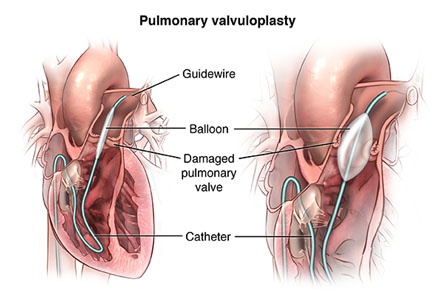Valvuloplasty
Introduction
Balloon valvuloplasty is a surgical procedure which involves opening of a narrowed heart valve.
Purpose:
Balloon valvuloplasty is performed on children and adults who have a narrowed heart valve, which is called as stenosis. The goal of the procedure is to improve the valve function and blood flow by enlarging the valve opening. This surgery is also sometimes used to avoid or delay open heart surgery and valve replacement.
There are four valves in the heart. These are the aortic valve, pulmonary valve, mitral valve, and tricuspid valve. These valves open and close during cardiac contraction to regulate the blood flow from one chamber to the next. The valves are important for the efficient functioning of the heart and circulatory system. Balloon valvuloplasty is used when narrowing of the valve is present and medical treatment has failed to relieve the related problems.
Valvular stenosis can be a congenital defect (develops in the fetus and is present at birth) or can be acquired (caused by some other condition).
Iran is among the top 10 countries in treating cardiovascular diseases, while it ranks first in the Middle East

Symptoms of valve stenosis:
• In children – Heart failure, blood pressure abnormalities, or a murmur.
• In adults – Blood pressure abnormalities, shortness of breath, chest pain (angina), irregular heart beat (arrhythmia), or fainting episodes (syncope).
Diagnosis
Electrocardiogram, x ray, and angiography (a special x-ray examination using dye in the vascular system) may be performed to identify valvular heart problems. Cardiac catheterization may also be performed to examine heart valve function before advising a surgical procedure.
Procedure:
The procedure usually takes about four hours and it is performed in a cardiac catheterization laboratory under fluoroscopic (live X-ray) guidance. The patient is made to lie down on an x-ray table and covered with a sterile sheet. An area on the inside of the thigh is cleansed and the site of catheter insertion is treated with an antibacterial solution. The patient is given local anesthesia to numb the insertion site. Children usually need general anesthesia for this procedure. Adult patients are awake during the surgery. After this, the cardiologist inserts a catheter into the appropriate blood vessel and passes a smaller balloon-tipped catheter through the first catheter. Under X-ray guidance, the physician slowly threads the catheter up into the coronary artery to the heart. The deflated balloon is carefully passed across the valve opening and then is inflated repeatedly and quickly, which applies pressure to dilate the valve. The inflated balloon causes splitting of the valve leaflets, thus widening the valve opening. After this, the balloon-tipped catheter is removed. The outer catheter remains in place for about six to 12 hours if in case repeat procedure is needed. A double-balloon valvuloplasty procedure is often performed in certain high-risk patients as it is considered more effective in restoring the blood flow.
Preparation
Patient should not eat or drink anything for at least six hours before balloon valvuloplasty. An intravenous line is inserted for delivering medications (anticoagulants to prevent clot formation and radioactive dye for x rays). The patient’s groin area is shaved and cleaned with an antiseptic. The patient is given an oral sedative about an hour before the procedure for relaxation.
Aftercare
Balloon valvuloplasty is considered a safe, effective treatment in children with congenital stenosis, improving heart function and blood flow.
After balloon valvuloplasty, the patient is monitored for about an hour in the recovery room to check the vital signs (such as heart rate, breathing and ECG). For at least 30 minutes after removal of the catheter, direct pressure is applied to the site of insertion. Then a pressure dressing is applied on the wound. The insertion site will be observed for bleeding until the catheter is removed. The leg in which the catheter was inserted is temporarily prevented from moving. Intravenous anticoagulants or other medications may be administered to improve blood flow. Pain medication is administered if needed. Some patients may need to continue taking anticoagulant medications for months or years after the surgery.
Following discharge from the hospital, the patient can usually resume normal activities. Lifelong follow-up is necessary after surgery as sometimes the valve can degenerate or narrowing recurs. This restenosis will likely require repeat valvulplasty, valvotomy, or valve replacement in future.
Risks:
The complications of balloon valvuloplasty can include:
1. The valve may not close completely, which makes the condition worse. This is called regurgitation.
2. Embolism of clots or pieces of valve tissue
3. Severe damage to the valve leaflets, leading to need for immediate valve replacement
4. Bleeding and hematoma at the puncture site
5. Arrhythmias
6. Heart attack
7. Heart puncture
8. Infection
9. Possibility of restenosis
Normal results
Balloon valvuloplasty is considered a safe, effective treatment in children with congenital stenosis, improving heart function and blood flow. In adults, the most successful valvuloplasty results are achieved in treating narrowed pulmonary valves, although the treatment of mitral valve stenosis is also generally good. The aortic valve procedure is more difficult to perform and is generally less successful.